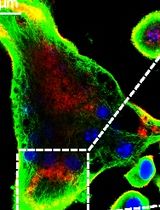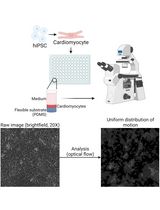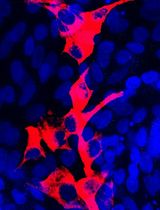- EN - English
- CN - 中文
Hair Follicle Stem Cell Isolation and Expansion
毛囊干细胞的分离和扩增
发布: 2018年05月20日第8卷第10期 DOI: 10.21769/BioProtoc.2848 浏览次数: 8887
评审: Vivien Jane Coulson-ThomasAnca SavulescuAnonymous reviewer(s)
Abstract
Stem cells are widely used for numerous clinical applications including limbal stem cell deficiency. Stem cell derived from the bulge region of the hair follicle have the ability to differentiate into a variety of cell types including interfollicular epidermis, hair follicle structures, sebaceous glands and corneal epithelial cells when provided the appropriate cues. Hair follicle stem cells are being studied as a valuable source of autologous stem cells to treat disease. The protocol described below details the isolation and expansion of these cells for eventual clinical application. We used a dual-reporter mouse model to visualize both isolation and eventual differentiation of these cells in a limbal stem cell-deficient mouse model.
Keywords: Holoclones (全克隆)Background
Stem cells are widely used for a multitude of translational and clinical applications. One such clinical application is for the treatment of limbal stem cell deficiency (LSCD). LSCD occurs when there is dysfunction or loss of the limbal stem cell population, which is critical for maintaining a healthy ocular surface, due to congenital or acquired pathologies. The primary treatment strategy for LSCD is cultivating autologous epithelial cell sheets from a limbal biopsy of the patient’s healthy eye (Pellegrini et al., 1997; Shortt et al., 2007). The limitation of this strategy is that it is only applicable for patients that have unilateral LSCD. Those that have bilateral LSCD, must rely on an allogenic limbal biopsy from an immunologically related living donor or cadaveric tissue. Due to the need of systemic immunosuppressive therapy and the limited availability of donor tissue, the therapeutic success rate is decreased. Several research groups have been examining the use of cultivated oral mucosal cells for the treatment of LSCD and have achieved some success. However, these cells often fail to express the corneal epithelial differentiation marker, Keratin 12 (Inatomi et al., 2006) and often result in the development of peripheral neovascularization (Nakamura et al., 2004; Nishida et al., 2004; Ma et al., 2009). Due to these limitations, there was a need for an alternative source of autologous stem cells. Thus we focused on the use of hair follicle stem cells as they harbor multiple sources of stem cells that have been used in regenerative medicine (Cotsarelis et al., 1990; Purba et al., 2014). The hair follicle contains mesenchymal stem cells in the dermal papilla and connective tissue sheath, which can give rise to several cell lineages (Lako et al., 2002; Jahoda et al., 2003; Richardson et al., 2005). Additionally, the bulge region of the hair follicle contains stem cells, which can generate the interfollicular epidermis, hair follicle structures and sebaceous glands (Cotsarelis et al., 1990; Taylor et al., 2000; Cotsarelis, 2006). The hair follicle stem cells (HFSC) derived from the bulge region express of variety of cytokeratins including cytokeratin 15 (Krt15) (Tiede et al., 2007; Kloepper et al., 2008; Larouche et al., 2008), which has been successfully used for the purification and enrichment of HFSC (Blazejewska et al., 2009). HFSC have been successfully used in the treatment of a mouse model of LSCD (Meyer-Blazejewska et al., 2011) and research continues to focus on other therapeutic applications and the eventual translation to humans (Purba et al., 2014). Continued research efforts into these areas rely on a standard method for isolating and expanding the bugle-derived HFSC.
Materials and Reagents
- Pipette tips (MidSci, Avant low binding tips)
- 35-mm cell culture dish (Thermo Fisher Scientific, catalog number: 153066 )
- 6-well plates (Corning, Falcon®, catalog number: 353934 )
- 100 mm cell culture dish (Thermo Fisher Scientific, Thermo ScientificTM, catalog number: 150464 )
- NIH-3T3 cells (ATCC, catalog number: CRL-1658 )
- 3-5 week old K12rtTA/rtTA/TetO-Cre/RosamTmG (see Notes)
- Ketamine/HCl 100 mg/ml (KetaJect; Henry Schein Animal Health, catalog number: 010177 )
- Xylazine AnaSed® 100 mg/ml (Santa Cruz Biotechnology, catalog number: sc-362949Rx )
- Collagenase A (Sigma-Aldrich, Roche Diagnostics, catalog number: 10103578001 )
- Dispase II (Sigma-Aldrich, catalog number: 4942078001)
Manufacturer: Roche Diagnostics, catalog number: 04942078001 . - Mitomycin C (Sigma-Aldrich, catalog number: M7949-2MG )
- Phosphate buffered saline (PBS)
- Trypsin (2.5%) (Thermo Fisher Scientific, GibcoTM, catalog number: 15090046 )
- Versene (Thermo Fisher Scientific, GibcoTM, catalog number: 15040066 )
- Dulbecco’s modified Eagle medium (DMEM) without calcium and magnesium (Thermo Fisher Scientific, GibcoTM, catalog number: 21068028 )
- Ham’s F12 Nutrient Mix (Thermo Fisher Scientific, GibcoTM, catalog number: 11765047 )
- Fetal Bovine Serum (Thermo Fisher Scientific, GibcoTM, catalog number: 10082147 )
- Human recombinant epidermal growth factor (Merck, catalog number: GF144 )
- L-Glutamine (Thermo Fisher Scientific, GibcoTM, catalog number: 25030081 )
- Calcium Chloride solution 1 M (Sigma-Aldrich, catalog number: 21115 )
- Human corneal growth supplement (Thermo Fisher Scientific, GibcoTM, catalog number: S0095 )
- Penicillin-streptomycin (10,000 U/ml) (Thermo Fisher Scientific, GibcoTM, catalog number: 15140148 )
- Amphotericin B (Thermo Fisher Scientific, catalog number: 15290026 )
- Dulbecco’s modified Eagle medium (DMEM) high glucose (Thermo Fisher Scientific, GibcoTM, catalog number: 11960044 )
- Stem Cell Media (see Recipes)
- 3T3 media (see Recipes)
Equipment
- Pipettes
- Microdissection scissors (Fine Science Tools, catalog number: 15000-00 )
- Forceps (Fine Science Tools, catalog number: 11252-23 )
- Scissors (Fine Science Tools, catalog number: 14060-09 )
- Hemocytometer (Hausser Scientific, catalog number: 3200 )
- Dissecting Scope (ZEISS, model: Stemi DV4 )
- BSL2 Laminar flow hood (Thermo Fisher Scientific, Thermo ScientificTM, model: 1300 Series A2 , catalog number: 1387)
- CO2 incubator (Thermo Fisher Scientific, Thermo ScienticTM, model: NAPCO Series 8000 WJ )
- Centrifuge (Hettich, model: Rotina 35 )
- Inverted fluorescent microscope (Zeiss Observer Z1 with an apotome attachment) (ZEISS, model: AxioObserver Z1 )
Software
- AxioVison 4.7
- ImageJ
Procedure
文章信息
版权信息
© 2018 The Authors; exclusive licensee Bio-protocol LLC.
如何引用
Call, M., Meyer, E. A., Kao, W. W., Kruse, F. E. and Schloetzer-Schredhardt, U. (2018). Hair Follicle Stem Cell Isolation and Expansion. Bio-protocol 8(10): e2848. DOI: 10.21769/BioProtoc.2848.
分类
干细胞 > 成体干细胞 > 上皮干细胞
细胞生物学 > 细胞分离和培养 > 细胞分化
您对这篇实验方法有问题吗?
在此处发布您的问题,我们将邀请本文作者来回答。同时,我们会将您的问题发布到Bio-protocol Exchange,以便寻求社区成员的帮助。
Share
Bluesky
X
Copy link












